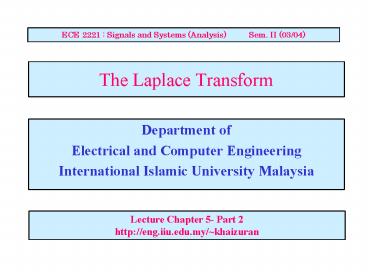The Laplace Transform - PowerPoint PPT Presentation
1 / 17
Title:
The Laplace Transform
Description:
The Laplace Transform. Department of. Electrical and Computer Engineering ... Theorem 5: Time-Delay. Example: Find the Laplace transform for the following signal, ... – PowerPoint PPT presentation
Number of Views:66
Avg rating:3.0/5.0
Title: The Laplace Transform
1
The Laplace Transform
ECE 2221 Signals and Systems (Analysis)
Sem. II (03/04)
- Department of
- Electrical and Computer Engineering
- International Islamic University Malaysia
Lecture Chapter 5- Part 2
http//eng.iiu.edu.my/khaizura
n
2
Laplace Transform Theorems
- Theorem 1 Linearity
Example Find the L.T for the following signal
using linearity theorem. x(t)cos 2pfot u(t)
3
Theorem 2 Differentiation
Example Consider the circuit below
Find the current through the inductor as a
function of time
4
Solution
5
Theorem 3 Integration
Example Find the Laplace transform for the
current, i(t) as shown in the circuit below
Solution
6
Theorem 4 Complex Frequency Shift (S-Shift)
Example Find the Laplace transform for the
following signal,
x(t)e-3t(cos2t 2.5sin2t) tgt0 Solution
7
Theorem 5 Time-Delay
Example Find the Laplace transform for the
following signal, x(t)
u(t) - 2u(t-3) 2u(t-6) Solution
8
Theorem 6 Convolution of Two Signals
Example Find the Laplace transform for the
following signal, Solution
9
Theorem 8 Initial Value Theorem
Theorem 9 Final Value Theorem
Example Determine the initial and final values
of a signal x(t) whose Laplace transform is
Solution
10
Another Example of Using the Final and Initial
Values Theorem
- Transfer function
- Poles at s 0, s -1 ? j2
- Zero at s -3/2
Initial Value
Final Value
11
Inverse Laplace Transform
- Definition has integration in complex plane
- We will use lookup tables instead
- Table 5.3
- Many Laplace transform expressions are ratios of
two polynomials, a.k.a. rational functions - Convert complicated rational functions into
simpler forms - Apply partial fractions decomposition
- Use lookup tables
12
Partial Fractions Example 1
13
Partial Fractions Example 2
14
Partial Fractions Example 3
15
More Examples of How to find the Inverse Laplace
Transform
- Refer to Examples No. 5-9 to 5-14 (text book)
16
The Double-Sided Laplace Transform
- Used for signals that are nonzero for tlt0
- Same as single-sided L.T except that the lower
limit on the integral is -? - The function of s denoting a double sided L.T
does not correspond to a unique inverse laplace
transform. Rather, both the function of s and the
ROC of the L.T must be specified to define a
unique inverse transform
17
Example
Solution
Ims
Res
-3
2































